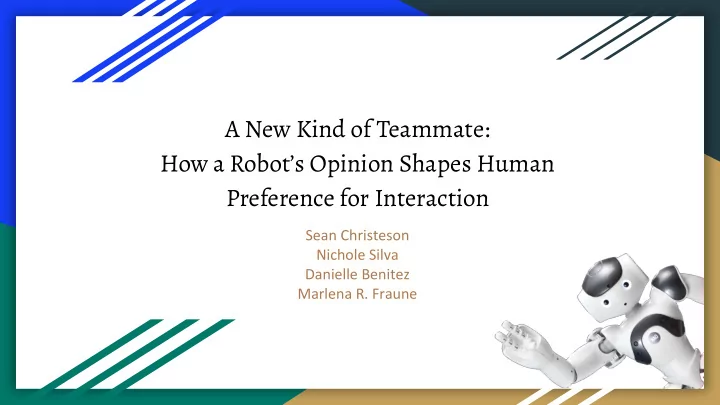

A New Kind of Teammate: How a Robot’s Opinion Shapes Human Preference for Interaction Sean Christeson Nichole Silva Danielle Benitez Marlena R. Fraune
Introduction Robots are becoming more prevalent. For them to help people, we must learn how best to work with ● them. Robots should maximize efgective communication with humans across cultures (Hui, 1988). ● Individualism (IND): place personal interest over shared group goals ○ Collectivism (COL): place group interest over individual goals ○ Collectivism may increase preference for robot teammates that use group-based language whereas ● individualism may increase preference for individual-based language (Smith & Mackie, 2015).
Introduction Cultural difgerences in the acceptance of robots has already been observed (Kaplan, 2004). ● A previous study examining participant group identification with a robotic partner based on ● language use found that participants prefered group-based language (Correia et. al, 2018).
Method Survey Game Attitude towards the robot (Correia et Participants “compete” with a team in ● ● al., 2018). Portugal. Individualism/Collectivism (Triandis & Estimation Game: Participants and the ● ● Gelfland, 1998). robot estimate an answer. Group Identification (Triandis et al., Participants input the final answer. ● ● 1988). Robots express emotion according to ● Demographics- nationality, gender, and the condition. ● condition utilized on the participant. The participant was not made aware if ● they lost or won the game against the team in Portugal.
Method Game Conditions ● Individual based emotion (e.g.,”I am impressed with your guess”) ○ Group based emotion (e.g., “I am impressed with our performance”) ○ Positive Negative Group-Based We work well together! We were not so good this time... We are the best! We may have estimated incorrectly... Individual-Based I am impressed with your I am so ashamed of my guess.. performance! Next time I will try harder... That was a great guess on your part!
Hypothesis [H1] - Participants will respond more positively towards robots that display more ● group-based language compared to individual-based language. [H2] - Participants will respond more negatively towards robots that display more ● individual-based language compared to group-based language.
Results n = 7, p = .428 n = 7, p = .009
Discussion There was no difgerence between the two groups in terms of positive emotions or attitudes ● (H1 not supported). Participants showed significantly more negative emotions in the individual-based condition ● than the group-based condition (H2 supported). Our data aligns with the previously study in Portugal (Correia et al., 2018), in that ● individual-based language elicited more negative emotions. However, due to the low number of participants ( n = 7), it is ill-advised to draw conclusions ● without further testing.
Future Directions Participant INDCOL scores can be used as another measure to test individual or group-based ● language against. In particular, the hypotheses would be that more collectivistic participants would prefer ○ group-based language, while more individualistic participants would prefer individual-based language.
References Correia, F., Mascarenhas, S., Prada, R., Melo, F. S., & Paiva, A. (2018). Group-based emotions in teams of humans and robots. Proceedings of the 2018 ACM/IEEE International Conference on Human-Robot Interaction - HRI 18. doi:10.1145/3171221.3171252 Hui, H.C. (1988). Measurement of individualism-collectivism. Journal of Research in Personality, 22, 17-36. doi:10.1016/0092-6566(88)90022-0 Kaplan, F. (2004). Who is afraid of the humanoid? Investigating cultural difgerences in the acceptance of robots. International Journal of Humanoid Robotics, 1 (3), 1-16. https://doi.org/10.1142/s0219843604000289 Smith, E. R., & Mackie, D. M. (2015). Dynamics of group-based emotions: insights from intergroup emotions theory. Emotion Review, 7, (4), 349-354. doi:10.1177/1754073915590614 Triandis, H. C., Bontempo, R., Villareal M. J., Asai, M., & Lucca, N. (1988). Individualism and collectivism: Cross-cultural perspectives on self-ingroup relationships. Journal of Personality and Social Psychology, 54(2), 323-338. doi:10.1037/0022-3514.54.2.323 Triandis, H. C. & Gelfland, M. J. (1998). Converging measurement of horizontal and vertical individualism and collectivism. Journal of Personality and Social Psychology, 74, 118-128.
Recommend
More recommend